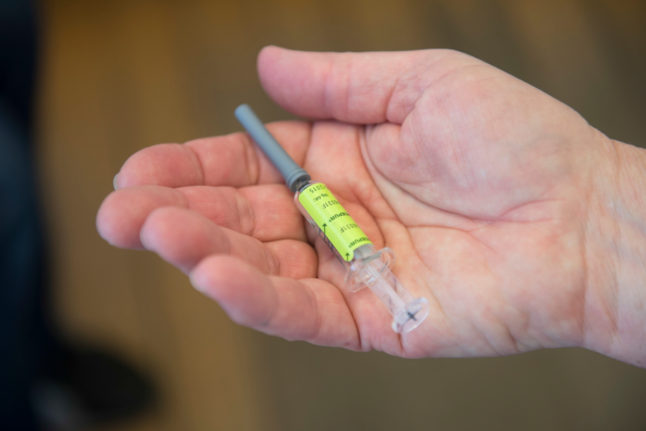TBE, or Tick-borne encephalitis, is one of the two main tick-borne diseases in Sweden (Lyme disease is the other one).
It is a viral brain infection, which can cause a range of symptoms, usually starting with typical flu-like symptoms and then developing to include nausea, dizziness, and in around a third of cases, severe problems.
Symptoms usually appear around a week after the bite, but can take longer. There is no cure, but it can be treated, and there is a vaccination too.
The tick season tends to last from March to November, peaking in April to mid-June. According to the Public Health Agency, most TBE cases however tend to be recorded during the summer, as that’s the period when people spend the most time outdoors.
TBE is relatively rare, but has been on a fairly steady increase in Sweden in the past decade, from 178 confirmed cases in 2014 (or an incidence rate of 1.83 per 100,000 people) to 595 cases in 2023 (incidence rate 5.64), according to the Public Health Agency’s statistics.
Who should get vaccinated?
Because the infection can in a few cases lead to serious consequences, anyone who lives in an area where there’s a high concentration of ticks carrying TBE is recommended to get vaccinated.
That includes people who live there permanently and who have temporary summer homes, as well as people who spend a lot of time outdoors in these areas, but there’s no strict cut-off point.
Not all ticks carry TBE, and they have historically been concentrated in southern parts of Sweden and the Stockholm archipelago, but have been spreading across the country in recent years.
The regions that recorded the most number of cases last year were Stockholm (160, or an incidence rate of 6.52 per 100,000 people), Västra Götaland (121, or 6.85), Södermanland (55, or 18.22), Uppsala (52, or 12.85), Västmanland (33, or 11.75) and Värmland (31, or 10.93).
The only region that didn’t record a single case of TBE in 2023 was Gotland. Jämtland, Västerbotten and Västernorrland recorded one case each, and Norrbotten two cases.
You may want to contact your regional health services for specific information. Skåne, for example, only recorded 21 cases last year (an incidence rate of 1.48), but TBE is more common in certain parts of the region than others, and the region recommends that people living in these parts get vaccinated – there’s more information to be found on the region’s TBE vaccine page.
You can of course also get vaccinated even if you don’t live in a high-risk area, especially if you spend a lot of time in the forest or tall grass.
How can I get vaccinated?
You can search for healthcare centres near you through 1177.se or the website Fästing.nu (fästing is the Swedish word for tick – don’t confuse it with fästning, a fortress). To view regional information on 1177, go to the top of the page and click välj region (choose region).
The vaccine is not part of Sweden’s national vaccination programme, so you have to pay for it.
In Östergötland, the vaccine is subsidised by the region, so each dose of the initial three doses costs 200 kronor for adults. In a lot of other regions, including Stockholm, it costs around 400 kronor.
Only Sörmland, Uppsala, Västmanland, Östergötland and Jönköping offer the vaccine for free to children and teenagers, at least the basic vaccination schedule of the initial three doses.
How does the vaccine work?
You start with three doses (or four if you’re over 50), usually the first two within the space of one to three months and the third dose ahead of the next season, no more than a year after the second dose.
Each of these doses increases your level of protection, but because you need several to be fully protected, it’s recommended that you begin the vaccination programme well ahead of tick season.
You then get a fourth (or fifth if you’re over 50) top-up dose after three years, and will need top-ups every five years.
Children under the age of 15 are recommended to get the second dose one month after the first dose, then the third dose after 5-12 months. After that they follow the same schedule as adults, so a fourth dose after three years followed by top-ups every five years.
People with an impaired immune system due to underlying health issues are recommended to follow the same schedule as over-50s. They may not be able to reach a full level of defence against TBE, but the vaccine will offer enough protection that they are still recommended to get it.



 Please whitelist us to continue reading.
Please whitelist us to continue reading.
Are there any side effects that one must be aware of before taking the shot?
Hi, just the usual ones such as redness or pain at the injection site, or for some people slight tiredness, fever or headache. According to the Public Health Agency, fever is a fairly common side effect especially among young children, and especially after the first dose. Serious side effects are very rare.
In the USA, the vaccine is $550.00 each shot. 400 SEK is a bargain.
I felt no effects from the vaccine. In fact, I loaded up on several vaccines at the same time for the first- Covid, Flu, TBE, Hep A+B within a few days and I did not feel any ill effects (ok my arms were sore). My grandkids were also vaccinated, and they had no ill effects. We may use a different vaccine in the USA for TBE (Ticovax).